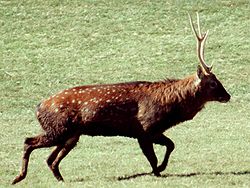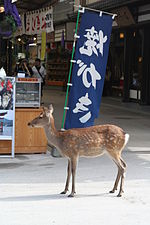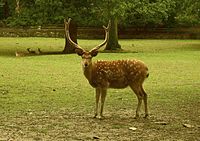- Sika Deer
-
Not to be confused with Sitka deer.
Sika Deer 
Male (stag) 
Females (Hinds) Conservation status Scientific classification Kingdom: Animalia Phylum: Chordata Class: Mammalia Order: Artiodactyla Family: Cervidae Subfamily: Cervinae Genus: Cervus Species: C. nippon Binomial name Cervus nippon
Temminck, 1838Subspecies See text
The Sika Deer, Cervus nippon, also known as the Spotted Deer or the Japanese Deer, is a species of deer native to much of East Asia and introduced to various other parts of the world. Previously found from northern Vietnam in the south to the Russian Far East in the north,[1] it is now on the brink of extinction in all areas except Japan, where the species is overabundant.[2] Its name comes from shika (鹿), the Japanese word for "deer".
Contents
Taxonomy
The Sika Deer is a member of the genus Cervus, a group of deer also known as the "true deer".[citation needed] Formerly Sika were grouped together in this genus with nine other species. Now, only the Sika and Red Deer remain, the latter being divided into three separate species European Red Deer, Central Asian Red Deer and American Elk (though this remains controversial [3]) This is because recent DNA evidence indicates that these deer are not as closely related as previously thought resulting in the creation of new species and genera. The genera Rucervus, Rusa, and Przewalskium are where most of the former Cervus species now belong. The ancestor of all Cervus probably originated in Central Asia and resembled Sika Deer.[4] All Cervus species can crossbreed and produce hybrids in areas where they co-exist (for example introduced Sika hybridize with native Red Deer in the Highlands of Scotland were this is a serious threat to the gene pool of the red deer population).
Subspecies
There has been serious genetic pollution in many populations, especially in China. Therefore the status of many subspecies remain unclear.[1] The status of C. n. hortulorum is particularly uncertain and might in fact be of mixed origin, hence it is not listed here.
- C. n. aplodontus, Northern Honshu
- C. n. grassianus, Shanxi, China
- C. n. keramae, Ryukyu Islands
- C. n. kopschi, Southern China
- C. n. mandarinus, Northern and Northeastern China
- C. n. mantchuricus, Northeastern China, Korea, and Russian Far East.
- C. n. nippon, Southern Honshu, Shikoku, and Kyushu
- C. n. pseudaxis, Northern Vietnam
- C. n. pulchellus, Tsushima Island
- C. n. sichuanicus: Western China.
- C. n. taioanus: Taiwan
- C. n. yesoensis: Hokkaido
Description
The Sika deer is one of the few deer species that does not lose its spots upon reaching maturity. Spot patterns vary with region. The mainland subspecies have larger and more obvious spots, in contrast to the Taiwanese and Japanese subspecies, whose spots are nearly invisible. Many introduced populations are from Japan and thus also lack significant spots.
The color of the fur ranges from mahogany to black, and white individuals are also known. During winter the coat becomes darker and shaggier and the spots less prominent, and a mane forms on the back of the males' necks.[5] They are medium sized herbivores, 50–95 centimetres (20–37 in) tall at the shoulder and weighing 30–70 kilograms (66–150 lb). Males are noticeably larger than females. All Sikas are compact and dainty-legged with short, trim, wedge-shaped heads and a boisterous disposition. When alarmed, they will often display a distinctive flared rump, much like the American Elk.
Sika stags have stout, upright antlers with an extra buttress up from the brow tine and a very thick wall. A forward-facing intermediate tine breaks the line to the top, which is usually forked. Occasionally sika antlers develop some palmation (flat areas). Females carry a pair of distinctive black bumps on the forehead. Antlers can range from 28 to 45 centimetres (11 to 18 in) to more than 80 centimetres (30 in) depending on the subspecies. Stags also have a distinctive mane during the rut.
Behavior
The sika deer can be active throughout the day, though in areas with heavy human disturbance they tend to be nocturnal. Seasonal migration is known to occur in mountainous areas such as Japan, with winter ranges being up to 700 metres (2,300 ft) lower than summer ranges.[5] Lifestyles vary between individuals, with some occurring alone while others are found in single-sex groups. Large herds will gather in autumn and winter. The Sika Deer is a highly vocal species, with over 10 individual sounds ranging from soft whistles to loud screams.
Sika males are territorial and keep harems of females during the rut, which peaks from early September through October but may last well into the winter months. Territory size varies with type of habitat and size of the buck; strong, prime bucks may hold up to 2 hectares (5 acres). Territories are marked with a series of shallow pits or scrapes, into which the males urinate and from which emanates a strong, musky odor. Fights between rival males are sometimes fierce and long, and may even be fatal.
In Nara, Japan, the deer are also known as 'bowing deer' as they bow their heads before you feed them. Simply purchase some deer-crackers from the shops in the park and hold one up to the deer (in front and slightly above its head). The deer will then bow its head before taking the cracker from your hand.
Habitat
Sika Deer are found in the temperate and subtropical forests of Eastern Asia, preferring areas with dense understory, and where snowfall does not exceed 10–20 centimetres (4–8 in). They tend to forage in patchy clearings of forests. Introduced populations are found in areas with similar habitats to their native range, including Western and Central Europe, Eastern United States, and New Zealand.
Population
The sika deer inhabits temperate and subtropical woodlands, which often occupy areas suitable for farming and other human exploitation. Its range encompasses some of the most densely populated areas in the world, where forests were cleared hundreds of years ago. The population status of Sika deer varies significantly in different countries. Although the species as a whole is thriving, it is endangered and extinct in many areas.
Japan has by far the largest native Sika population in the world. Though the exact population is uncertain it is likely to be in the hundred thousand range and is still increasing.[citation needed] This is mainly due to recent conservation efforts and the extinction of its main predator, the wolf, over a century ago. Without its main enemy the population of sika exploded and it is now overpopulated in many areas, posing a threat to both forests and farmlands. Efforts are now being made to control its population instead of conserving it. None of its subspecies are endangered except the Kerama Deer (C. n. keramae) in the tiny Ryukyu Islands.[2]
China used to have the largest population of Sika, but thousands of years of hunting and habitat loss has reduced the population to less than 1,000. Of the five subspecies in China, North China Sika Deer (C. n. mandarinus) is believed to be extinct in the wild since the 1930s, Shanxi Sika Deer (C. n. grassianus) has not been seen in the wild since the 1980s and is also believed to be extinct in the wild. The status of Manchurian Sika Deer in China is unclear, though it is believed to be extinct as well and the sightings there are actually feral populations. South China Sika Deer (C. n. kopschi) and Sichuan Sika Deer (C. n. sichuanicus) are the only remaining subspecies in the wild. The former exists in fragmented populations of around 300 in southeast China while the latter is found in a single population of over 400. The feral population is likely to be much higher than the wild though most of them are descended from domesticated sikas of mixed subspecies. All of the subspecies are present in captivity but a lack of suitable habitats and government efforts prevent reintroduction from happening.
The Formosan Sika Deer (C. n. taioanus) has been extinct for almost two decades before individuals from zoos were introduced to Kenting National Park and the population now numbers 200. Reintroduction programs are also under way in Vietnam, where the Vietnamese Sika Deer (C. n. pseudaxis) is extinct or nearly so.
Russia has a relatively large and stable population of 9,000 individuals of the Manchurian subspecies, but this is limited to a small area in Primorsky Krai. Small populations might exist in North Korea, but the political situation makes investigation impossible. The species is extinct in South Korea with no plans for reintroduction.
Introduced populations
Sika Deer have been introduced into a number of other countries including Australia, Austria, Denmark, Germany, Britain, France, Ireland, Jolo Island (southern Philippines), New Zealand, Poland, Morocco and the United States (Maryland, Texas, Wisconsin, Virginia, and Kansas). In many cases they were originally introduced as ornamental animals in parkland, but have established themselves in the wild. On Spieden Island, located in the San Juan Islands of Washington, they were introduced as a game animal.
In Britain and Ireland several distinct feral populations now exist. Some of these are in isolated areas, for example on the island of Lundy, but others are contiguous with populations of the native Red Deer. Since the two species sometimes hybridise, there is a serious conservation concern.[6] In research which rated the negative impact of introduced mammals in Europe, the Sika Deer was found to be among the most damaging to the environment and economy along with the Brown rat and Muskrat.[7]
In the 1900s, King Edward VII presented a pair of Sika Deer (Cervus nippon) to John, the second Baron Montagu of Beaulieu. This pair escaped into Sowley Wood and were the basis of the Sika to be found in the New Forest today.[citation needed] They were so prolific that culling had to be introduced in the 1930s to control numbers.[8]
Hunting
Across its original range and in many areas to which it has been introduced, the Sika is regarded as a particularly prized and elusive sportsman's quarry. In Britain, Ireland and mainland Europe it has been noted that Sika display very different survival strategies and escape tactics from the indigenous deer. They have a marked tendency to use concealment in circumstances when Red Deer, for example, would flee; and have been seen to squat and lie belly-flat when danger threatens.
Hunters and control cullers[who?] have estimated that the Sika's wariness and "cleverness" makes it three or four times more difficult to bring to bag than a Red or Fallow deer.[citation needed] It has also been said[citation needed] that Sika are much more tenacious of life, and harder to kill with a rifle bullet, than the native deer of Europe and North America. In the British Isles Sika are widely regarded as a serious threat to new and established woodlands, and public and private forestry bodies adopt policies of rigorous year-round culling.
Velvet antler
 Tame deer wandering the streets of Miyajima, Japan
Tame deer wandering the streets of Miyajima, Japan
Velvet antler (dried immature antlers) is a popular ingredient in traditional Chinese medicine, and Sika in China were domesticated long ago for the antler trade, along with several other species. In Taiwan, both Formosan Sika Deer and Formosan Sambar Deer (Cervus unicolor swinhoei) have been farmed for velvet antlers. Japan is the only country in Eastern Asia where Sika Deer were not farmed for velvet antlers.
Other deer raised for the antler trade were Thorold's Deer (Cervus albirostris), Central Asian Red Deer (Cervus affinis) and Wapiti (Cervus canadensis).
See also
- Red Deer - European Red Deer
- Central Asian Red Deer - Asian/Himalayan/Tibetan Red Deer
- Elk - East Asian/North American Red Deer (Wapiti)
- Thorold's Deer
- Deer of Great Britain
- Bambi
References
- ^ a b c Harris, R.B. (2008). Cervus nippon. In: IUCN 2008. IUCN Red List of Threatened Species. Downloaded on 5 April 2009. Database entry includes a brief justification of why this species is of least concern.
- ^ a b Kaji, Koichi; Takashi Saitoh, Hiroyuki Uno, Hiroyuki Matsuda, and Kohji Yamamura. "Adaptive management of sika deer populations in Hokkaido, Japan: theory and practice" (pdf). http://www.populationecology.org/SpecialIssueArticlePage.aspx?DOI=10.1007/s10144-010-0219-4. Retrieved 2011-01-19.
- ^ Ludt, Christian J.; Wolf Schroeder, Oswald Rottmann, and Ralph Kuehn. "Mitochondrial DNA phylogeography of red deer (Cervus elaphus)" (pdf). Molecular Phylogenetics and Evolution 31 (2004) 1064–1083. Elsevier. Archived from the original on September 27, 2004. http://web.archive.org/web/20040927110031/http://www.wzw.tum.de/wildbio/paper/cerphyl.pdf#search=%22Barbary%20red%20deer%22. Retrieved 2006-10-06.
- ^ Geist, Valerius (1998). Deer of the World: Their Evolution, Behavior, and Ecology. Mechanicsburg, Pa: Stackpole Books. ISBN 0-8117-0496-3.
- ^ a b "Ultimate Ungulate Fact Sheet - Sika Deer". http://www.ultimateungulate.com/artiodactyla/cervus_nippon.html2.[Full citation needed]
- ^ "Cross-breeding 'threat' to deer". BBC. 2009-01-22. http://news.bbc.co.uk/1/hi/scotland/edinburgh_and_east/7842458.stm.
- ^ "Rats top invasive mammals table". BBC News. 7 May 2010. http://news.bbc.co.uk/1/hi/science_and_environment/10100907.stm.
- ^ "British Mammals: Sika Deer". BBC. 15 June 2007. http://www.bbc.co.uk/dna/ptop/A23502926. Retrieved 8 October 2009.
- "Cervus nippon". Integrated Taxonomic Information System. http://www.itis.gov/servlet/SingleRpt/SingleRpt?search_topic=TSN&search_value=180696. Retrieved 10 February 2006.
- Igota, H., Sakagura, M., Uno, H., Kaji, K., Maneko, M., Akamatsu, R., & Maekawa, (in press). Seasonal patterns of female sika deer in eastern Hokkaidō, Japan. Ecological Research, 19.
Further reading
O'Brien, D.J., Roodey, S.M. and Hayden, T.J. 2009. A differential vulnerability to hunting between the sexes in Sika-type calves. I. Nat. J. 30: 7- 9.
External links
Extant Artiodactyla species Kingdom: Animalia · Phylum: Chordata · Class: Mammalia · Infraclass: Eutheria · Superorder: LaurasiatheriaSuborder Ruminantia Antilocapridae Giraffidae GiraffaMoschidae Tragulidae Cervidae Large family listed belowBovidae Large family listed belowFamily Cervidae Cervinae Indian Muntjac (M. muntjak) · Reeves's Muntjac (M. reevesi) · Hairy-fronted Muntjac (M. crinifrons) · Fea's Muntjac (M. feae) · Bornean Yellow Muntjac (M. atherodes) · Roosevelt's muntjac (M. rooseveltorum) · Gongshan muntjac (M. gongshanensis) · Giant Muntjac (M. vuquangensis) · Truong Son Muntjac (M. truongsonensis) · Leaf muntjac (M. putaoensis)DamaRucervusHyelaphusRusaRed Deer (C. elaphus) · Elk (C. canadensis) · Thorold's deer (C. albirostris) · Sika Deer (C. nippon)Capreolinae Red Brocket (M. americana) · Small Red Brocket (M. bororo) · Merida Brocket (M. bricenii) · Dwarf Brocket (M. chunyi) · Gray Brocket (M. gouazoubira) · Pygmy Brocket (M. nana) · Amazonian Brown Brocket (M. nemorivaga) · Yucatan Brown Brocket (M. pandora) · Little Red Brocket (M. rufina) · Central American Red Brocket (M. temama)Family Bovidae Cephalophinae Abbott's Duiker (C. spadix) · Aders' Duiker (C. adersi) · Bay Duiker (C. dorsalis) · Black Duiker (C. niger) · Black-fronted Duiker (C. nigrifrons) · Blue Duiker (C. monticola) · Harvey's Duiker (C. harveyi) · Jentink's Duiker (C. jentinki) · Maxwell's Duiker (C. maxwellii) · Red Forest Duiker (C. natalensis) · Ogilby's Duiker (C. ogilbyi) · Peters's Duiker (C. callipygus) · Red-flanked Duiker (C. rufilatus) · Ruwenzori Duiker (C. rubidis) · Weyns's Duiker (C. weynsi) · White-bellied Duiker (C. leucogaster) · Yellow-backed Duiker (C. Sylvicultor) · Zebra Duiker (C. zebra)Hippotraginae Reduncinae Aepycerotinae Peleinae Alcelaphinae Pantholopinae Caprinae Large subfamily listed belowBovinae Large subfamily listed belowAntilopinae Large subfamily listed belowFamily Bovidae (subfamily Caprinae) NaemorhedusPseudoisFamily Bovidae (subfamily Bovinae) Boselaphini Bovini Strepsicerotini Family Bovidae (subfamily Antilopinae) Antilopini Mountain Gazelle (G. gazella) · LitocraniusSaigini Neotragini Suborder Suina Suidae SusPalawan Bearded Pig (S. ahoenobarbus) · Bearded Pig (S. barbatus) · Indo-chinese Warty Pig (S. bucculentus) · Visayan Warty Pig (S. cebifrons) · Celebes Warty Pig (S. celebensis) · Flores Warty Pig (S. heureni) · Oliver's Warty Pig (S. oliveri) · Philippine Warty Pig (S. philippensis) · Boar (S. scrofa) · Timor Warty Pig (S. timoriensis) · Javan Pig (S. verrucosus)Tayassuidae Suborder Tylopoda Cetartiodactyla (unranked clade, higher than Artiodactyla) HippopotamusCategories:- IUCN Red List least concern species
- Cervus
- Megafauna of Eurasia
- Mammals of Japan
- Mammals of Asia
- Fauna of Korea
- Mammals of Taiwan
- Invasive animal species in the United States
- Non-native fauna of the British Isles
- Fauna of Ireland
- Mammals of Europe
Wikimedia Foundation. 2010.





